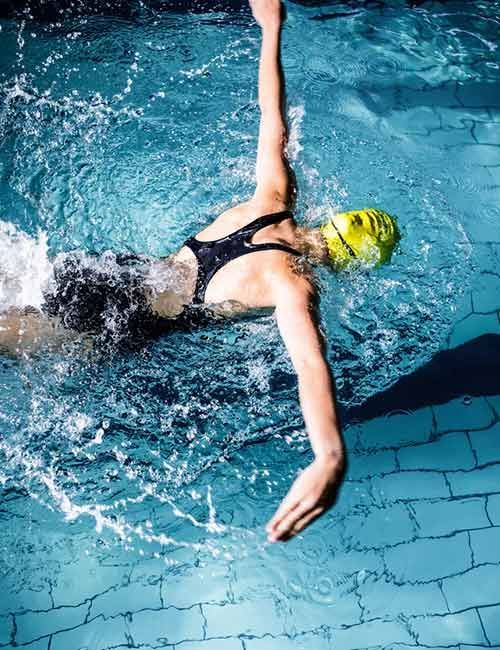Understanding the Butterfly Stroke
Before delving into the techniques, let’s gain a deeper understanding of the butterfly stroke itself. Known for its grace and power, the butterfly stroke is characterized by the simultaneous movement of both arms in an overhead motion while the legs perform a dolphin kick. It is also one of the most popular types of swimming strokes now. Its distinctive rhythm and undulating body motion make it a captivating stroke to watch and an exhilarating one to perform.
Body Position: Streamlining for Efficiency and Speed
Achieving the correct body position is crucial for a successful butterfly stroke. Begin by positioning your body horizontally in the water, ensuring it remains parallel to the surface. Your head should be aligned with your spine, facing downwards. Maintain a streamlined body position to minimize resistance and maximize efficiency. Focus on keeping your hips and legs high in the water, allowing for a smooth glide during each stroke.

Arm Movements: The Key to Power and Propulsion
The arm movements in butterfly stroke involve a powerful and coordinated motion to generate propulsion. Start with your arms extended forward, shoulder-width apart. As you initiate the stroke, simultaneously bring your arms out of the water and forward in a circular motion, resembling a half heart shape. Keep your elbows slightly bent and your palms facing outwards. As your arms reach the highest point, forcefully push them downwards towards your hips, propelling yourself forward. It’s important to maintain a continuous and fluid arm motion throughout the stroke.
Leg Movements: The Dolphin Kick
The dolphin kick is the signature leg movement in the butterfly stroke. Begin with your legs together and extended toward the surface. Bend your knees slightly, and as your arms start the upward motion, execute a powerful downward kick. The dolphin kick involves a simultaneous movement of both legs, with your feet and ankles acting as a single unit. Focus on generating propulsion by using your hip flexors and core muscles to create a fluid undulating motion. Remember, timing is crucial in the butterfly stroke – synchronize your leg kicks with the arm movements for maximum efficiency.
Mastering the Techniques: Step-by-Step Guide
Now that we have explored the fundamentals of the butterfly stroke, let’s dive into a step-by-step approach to mastering the techniques quickly:

Warm-up and Body Awareness
Before practicing the butterfly stroke, warm up your body with some light stretching and swimming exercises. This will help prepare your muscles for the specific movements involved in the stroke. Take a few moments to mentally visualize and familiarize yourself with the proper body position, arm movements, and leg kicks.
Flutter Kick Practice
Begin by focusing on perfecting your dolphin kick, or flutter kick, as it sets the foundation for the rest of the stroke. Practice the kick motion while holding onto the poolside or using a kickboard. Concentrate on generating power from your hips and core, while maintaining a steady and rhythmic motion. Gradually increase the intensity and speed of the kick as you become more comfortable.
Arm Stroke Coordination
Once you feel confident with your flutter kick, it’s time to incorporate the arm movements. Start by practicing the arm stroke on dry land, mimicking the circular motion and extension of the arms. Progress to the water, focusing on coordinating the arm movements with the leg kicks. Pay attention to maintaining a smooth and continuous motion, avoiding any pauses or jerky movements.
Technique Refinement and Endurance Building
Consistency and practice are essential for mastering the butterfly stroke. Dedicate regular sessions to refine your technique and build endurance. Seek guidance from experienced swimmers or coaches who can provide valuable feedback and help identify areas for improvement. Focus on maintaining a strong core, utilizing your hips efficiently, and refining the timing of your arm and leg movements.
Conclusion
Mastering the butterfly stroke takes time, dedication, and a patient approach. By understanding the key elements of body position, arm movements, and leg kicks, and following a systematic learning process, you can quickly progress in your butterfly stroke skills. Embrace the challenge, practice regularly, and celebrate each milestone along the way.


